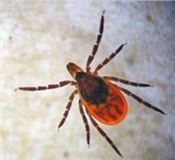Blacklegged Tick Adults Active During Winter
LEXINGTON, KY.
Adult blacklegged ticks (Ixodes scapularis) search for blood meals during the winter months (November through March). These cold-hardy ticks can be active whenever the temperature is above freezing. The female has long mouthparts and a distinctive orange-red body with a dark plate on the back (Figure 1). The smaller male has a completely dark back and legs.
The blacklegged tick is the primary vector of Lyme disease in the eastern US. This tick has a wide host range that includes large and small wildlife species, cats, dogs, and people. Historically, the incidence of Lyme disease in Kentucky has been very low but this could change as the tick becomes more widespread and contact with humans and pets become more frequent.
Repellents containing DEET or picaridin can be applied to the skin; clothing treatments of permethrin also are available. Insecticide-impregnated collars labeled for flea and tick control can protect pets.
The blacklegged tick is widely distributed in Kentucky (Figure 2) but more information is needed to monitor its presence and spread. Please submit specimens to your Cooperative Extension Office with information on the host and location. ∆
DR. LEE TOWNSEND: Extension Entomologist, University of Kentucky

Figure 1. Female blacklegged tick is active during the winter months. Note the long mouthparts and dark legs.
Photo: Lee Townsend, UK
 Figure 2. Distribution of the blacklegged tick (counties shaded in gray) based on a 2015-2016
Figure 2. Distribution of the blacklegged tick (counties shaded in gray) based on a 2015-2016
winter deer survey conducted by Kentucky Division of Fish and Wildlife Resources personnel.
Map provided by I. Stasiak, KDFWR